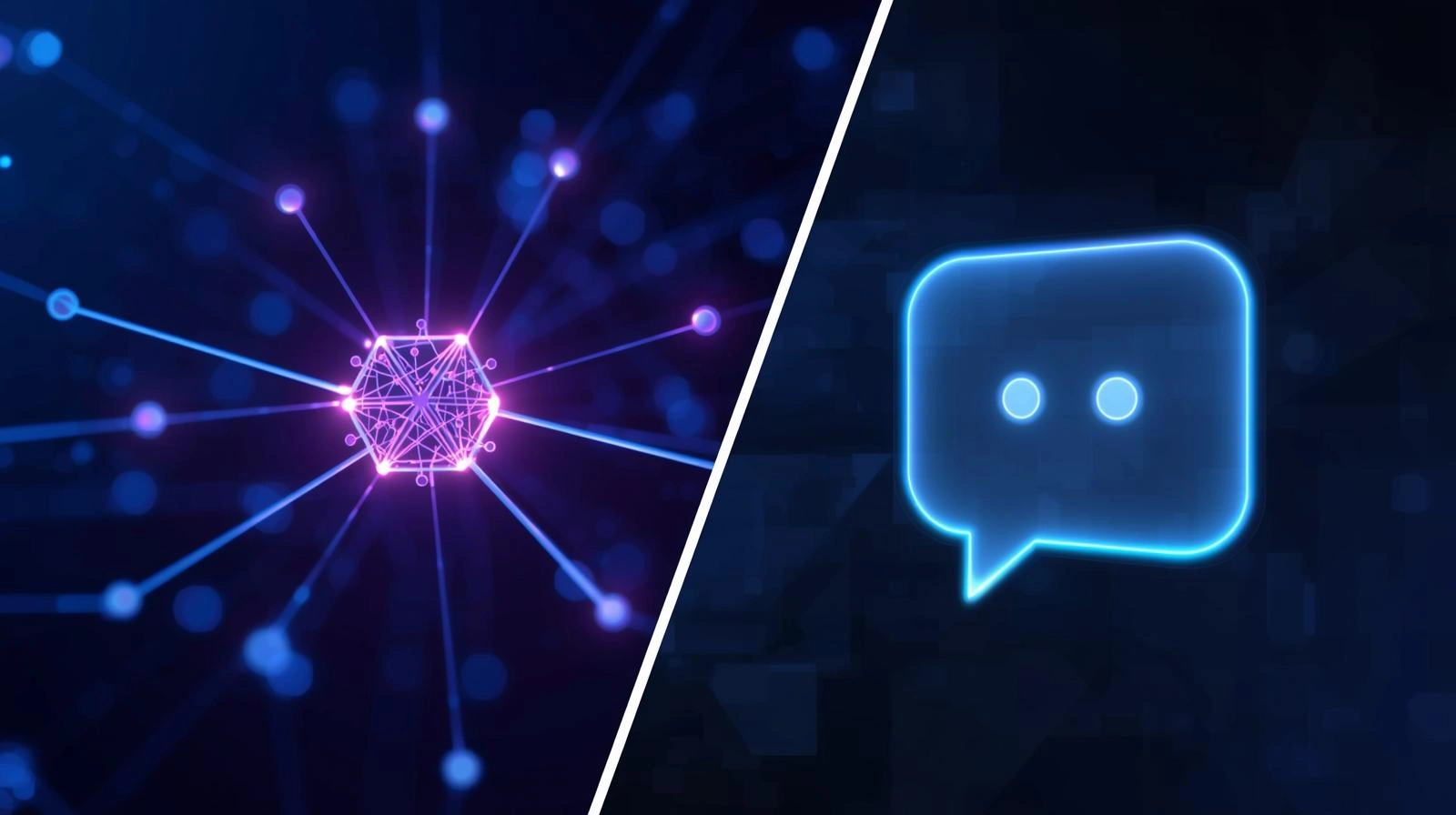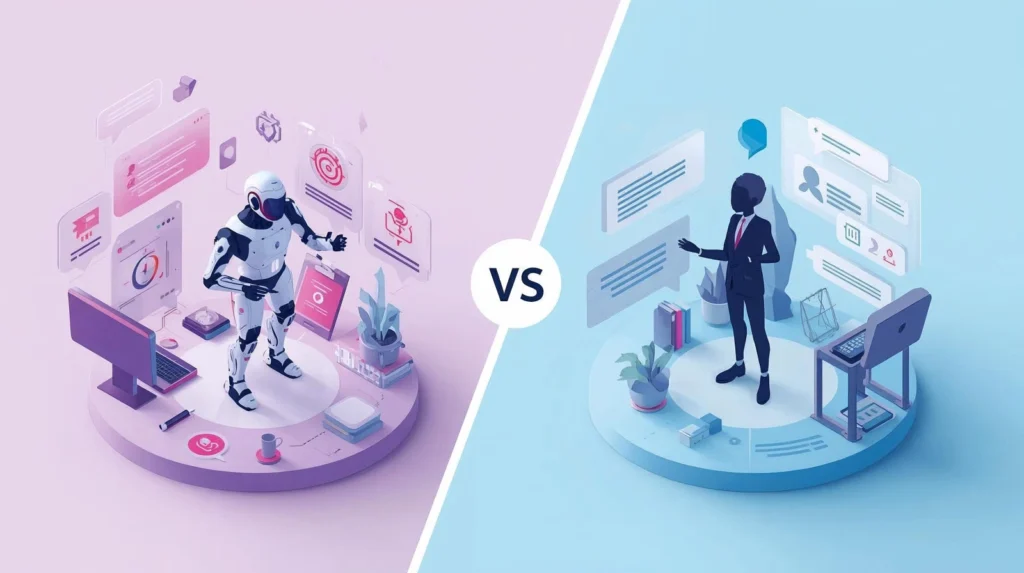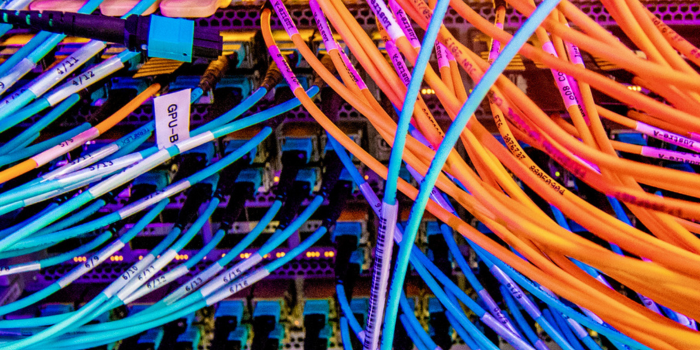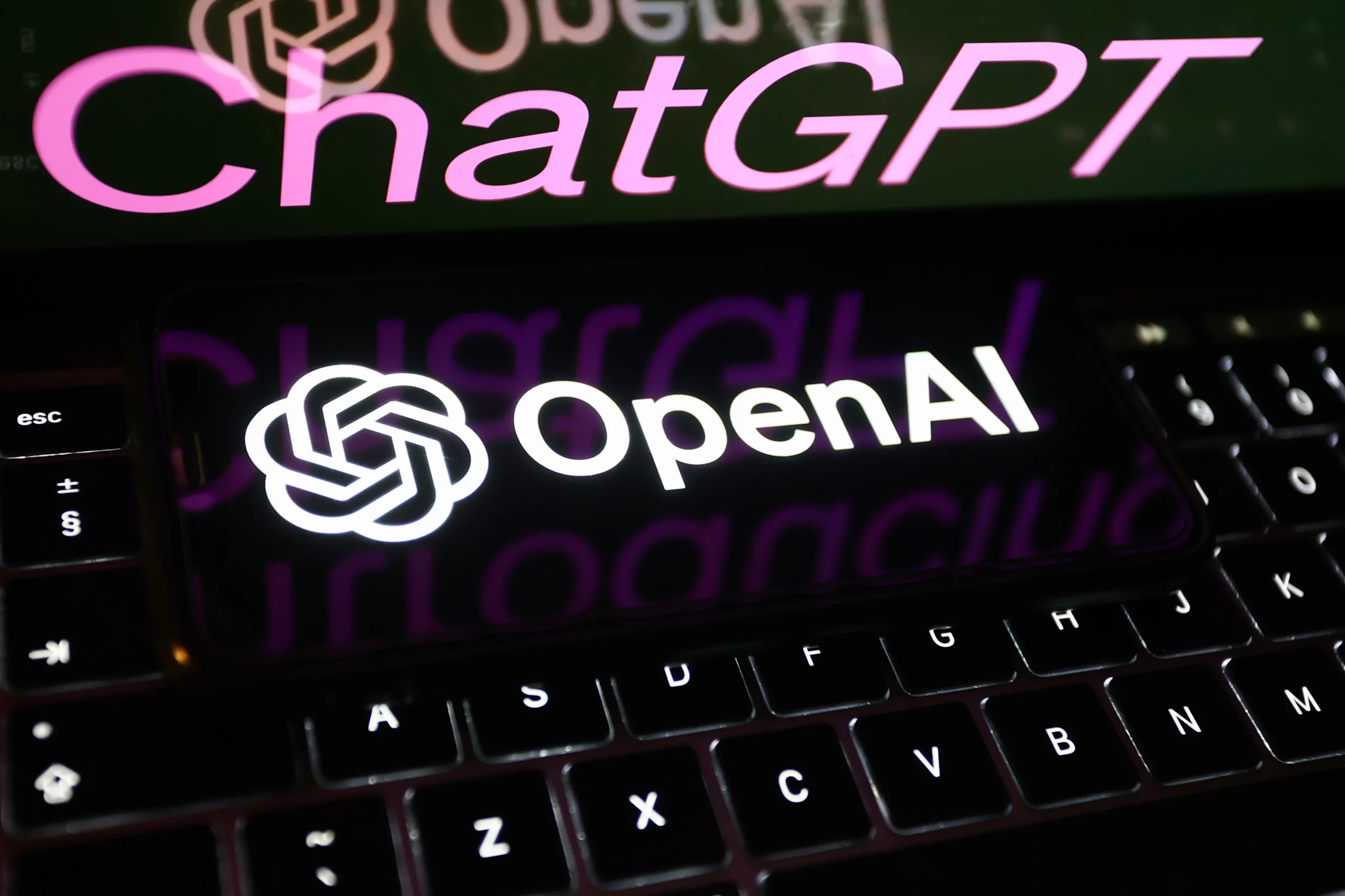AI AGENTS
AI Assistant
AI Agent vs AI Assistant: Key Differences, Benefits, and Use Cases

How many hours does your team lose each week chasing emails, answering the same customer questions, or juggling routine admin tasks? For most businesses, the number is staggering.
According to McKinsey, employees spend 60% of their time on repetitive tasks that could be automated. But the solution isn’t just to slap on any kind of automation and call it a day, either.
The question isn’t even if you’ll use AI: it’s how. Do you need an assistant to speed up daily tasks? Or do you need an agent that can act independently and make decisions in real time?
Confusing the two leads to wasted investments and missed opportunities.
In this guide, we’ll settle the AI agent vs AI assistant dilemma, break down the real differences between AI agents and AI assistants, and help you decide which one your business actually needs.
What Is an AI Agent?
An AI agent is a system that is fully autonomous and able to make decisions without human input. AI agents don’t just follow prompts and instructions, but also analyze the situation, adapt to the changing circumstances, and take action accordingly.
Think of an AI agent as your wingman. The Iceman to your Maverick. You both fly the same mission in formation, but an AI agent also has its own fighter jet, radar, and missiles, which gives it the ability to watch your six, as well as engage enemy aircraft on its own.
And it doesn’t have to be a jet with a pilot in it, but an autonomous drone that helps its human wingman, which is an even better representation of an AI agent.
Key Features of AI Agents
Here is a quick breakdown of the main characteristics of AI agents:
- Autonomy: Once you give them a goal, AI agents can operate without your instructions or oversight and figure out all the steps on their own. They are proactive and goal-oriented.
- Adaptability: AI agents are able to identify changes, such as sudden supply chain issues, and respond accordingly. They get better with each new experience.
- Decision-making capabilities: Agents are able to consider multiple variables (cost, risk, distance, time…) before choosing the best possible action.
- Multi-step workflows: Whether it’s just one agent or multiple ones, they are able to complete entire workflows from beginning to end.
- Scale: AI Agents are capable of handling data, interactions, or processes simultaneously on a large scale.
Limitations of AI Agents
AI agents are very capable, but they also come with their own set of challenges that your business needs to manage due to their autonomous nature:
- Complex building and training: Building and deploying an AI agent requires a great deal of effort in terms of technical knowledge, data, and integrations.
- Computational costs: AI agents’ advanced reasoning requires a very robust infrastructure.
- Ethical concerns: Because AI agents can make autonomous decisions, questions of accountability, ethics, and compliance might need to be answered.
- Lack of structure: AI agents might pursue unintended or even harmful goals without proper oversight and guardrails.
What Is an AI Assistant?
An AI assistant is a system to support human decision-making and tasks, usually through natural language commands and interactions. These are your Alexas, Siris, and ChatGPTs. AI assistants rely on human prompts and instructions to take action.
Continuing with our Top Gun analogy, an AI assistant is your copilot. The Goose to your Maverick. It’s right there with you in the cockpit, going through checklists, looking at the radar to identify bogeys, and providing navigation.
It does everything but fly the actual jet (although in real life, a copilot is trained to do this).
Key Features of AI Assistants
AI agents and AI assistants may still sound like similar concepts, but assistants also have their own unique traits, such as:
- Reactivity: Unlike the proactive AI agents, AI assistants are reactive and require human input in order to provide answers or take action. Also, they are task-oriented.
- Support: Because they are task-oriented, AI assistants excel at tasks that complement human activity, such as research, scheduling, or coming up with content drafts or edits.
- Task-specific: Every AI assistant is trained to follow predefined workflows and complete specific tasks.
- Context retention: Thanks to conversational AI, assistants can recognize intent, context, and nuance of a prompt, as well as remember previous inputs.
- User-centric: AI assistants aren’t here to replace humans, but to make them more productive.
Limitations of AI Assistants
While helpful, AI assistants are not the silver bullet when it comes to productivity. Here are some of their limitations:
- Dependency: They will act only when given human input. Otherwise, no action will be taken.
- Narrow scope: Each AI assistant is trained for a specific function, and it doesn’t have the ability to solve problems outside of it.
- Lack of decision-making: Great for quick answers and research, but lacking the strategic abilities of AI agents.
- Limited autonomy: AI assistants require supervision to perform multi-step goals.
AI Agent vs AI Assistant: What Is the Difference?
Most of the differences between agents and assistants boil down to how proactive or reactive they are, how they interact with human users, and how they go about solving tasks and goals.
Before a more in-depth comparison later in this blog, here is a direct AI agent vs AI assistant comparison table:
| Feature | AI Assistant | AI Agents |
| User Interaction | Reactive – responds to questions, commands, and prompts. | Proactive – able to act even when not asked. |
| Autonomy | Limited, requires human input and guidance. | Highly autonomous, makes decisions independently. |
| Goal/Task Orientation | Task-oriented. | Goal-oriented. |
| Learning and Adaptability | Learns from interactions but relies on fixed patterns and training data. | Continuously improves and adapts through feedback and new experiences. |
| Error Handling | Reports errors or asks for clarification. | Attempts self-correction and course adjustments. |
| Decision-making | Assists humans, but rarely acts on its own. | Makes complex, multi-variable decisions on its own. |
| Scope | Specific, well-defined tasks (e.g., reminders, FAQs, summaries). | Dynamic, complex, evolving processes (e.g., campaign optimization, logistics). |
| Interaction Type | Conversational and user-friendly. | Machine-to-machine, system-level, or hybrid human+system. |
| Complexity | Simple, fast, user-friendly. | Sophisticated, able to manage projects and autonomous workflows. |
| Control | High user control over outcomes. | Lower user control, operates within parameters and objectives. |
TL;DR for AI Assistants
AI assistants are reactive helpers that complete quick tasks through friendly conversational interaction.
Example: SmartCat’s Company Mind Assistant (CMA) is an AI chatbot that makes your company’s knowledge accessible in seconds, cutting search time by 50% and boosting query resolution speed by 70%.
CMA continuously improves, streamlines operations, and reduces time spent on marketing, sales, and information searches, turning complex documentation into quick, reliable insights.
Check out how Company Mind Assistant works in the video below:
TL;DR for AI Agents
AI agents are proactive collaborators that can handle complex workflows, adapt, and reach goals autonomously.
Example: SmartCat’s AI agent solutions that are custom-built to handle multi-step processes, ranging from agents for employee leave management to those capable of prospect scoring, data collection, and reporting automation for sales teams.
In reality, the AI agent vs AI assistant dilemma doesn’t really exist, as most businesses benefit from a combination of the two.
Want to see how chatbots stack up? Read our breakdown in AI Agent vs Chatbot: Explaining the Differences.
Benefits of AI Agents and AI Assistants

Both AI agents and AI assistants bring their own sets of advantages to modern businesses, but they shine in different ways.
Benefits of AI Agents
Here is how AI agents can help your business:
- Efficiency at scale: AI Agents never sleep and can handle thousands of repetitive tasks, from monitoring security threats to managing inventory.
- Real-time responsiveness: They are able to make split-second investments or make changes to supply chains during disruptions.
- Cost-cutting: Agents handle the repetitive, low-value work and free up humans for strategic and creative tasks.
- Fewer errors: AI agents don’t get tired, which eliminates the risk of human oversight, especially in data-heavy environments.
- Scalability: They easily scale up to meet demand, from customer service surges to enterprise-level analytics.
Benefits of AI Assistants
And here is how AI assistants can impact your business positively:
- Increased productivity: AI assistants take care of manual administrative work and research, while your team focuses on high-value tasks.
- Conversational interaction: Thanks to their ability to use natural language, AI assistants make for very intuitive partners.
- Integrations: AI assistants can easily integrate into your CRMs, apps, and existing workflows.
- Cost-effective: You can reduce operational costs by handing over routine tasks to AI assistants.
- Improved customer experience: Assistants deliver instant responses to customers and improve their satisfaction with your brand or business.
Together, AI agents and assistants are complementary solutions: AI agents autonomously optimize operations, while AI assistants make humans more productive and empowered.
AI Agent Use Cases
Let’s check out how AI agent abilities translate into real-life use cases and situations:
Customer Service and Experience
AI agents can act as the first line of customer support, help ticket vendors boost their operations by triaging tickets, pulling order data, and applying policy, while at the same time, handling refunds, rebookings, and RMAs.
The complex end-to-end workflow is completed through email, SMS, or push notifications.
Marketing and Growth
AI agents’ responsiveness enables them to view channel KPIs in real time and make adjustments to your campaigns.
For example, an AI agent can reallocate your ad budget from underperforming ads, run A/B tests, empower sales teams, sync findings back to analytics, generate briefs, and coordinate lunches across multiple channels.
Finance and Risk
AI agents can be used in fraud detection for scoring transactions, requesting step-up authentication, or blocking activity instantly.
Risk agents can evaluate portfolio exposure, suggest rebalancing, and model market shocks on the fly. On the compliance side, they monitor AML and KYC rules, generate audit-ready reports, and reduce the risk of penalties.
IT Operations and Cybersecurity
An AI agent monitors logs and performance metrics, opens incidents when something breaks, rolls back bad updates, and applies quick fixes.
Security agents can isolate hacked machines, reset credentials, patch known bugs, and check that fixes worked. All actions are audit-logged with approvals enforced for high-risk playbooks.
Supply Chain and Fulfillment
AI agents can forecast demand, generate POs, and reroute shipments if disruptions occur.
They can also detect stockouts early, notify customers, and coordinate dynamic pricing or substitutions, closing the loop across ERP, WMS, and last-mile carriers without human babysitting.
AI Assistant Use Cases
AI assistants work brilliantly in cases where speed, context, and human interaction are essential. Here are some real-life examples of how AI assistants can be used to remove friction for your organization, as well as for your clients:
Productivity and Workflow
You can rely on AI assistants to manage your calendar, set reminders, summarize email threads, and even onboard new employees, but their real value comes from orchestration.
A modern assistant can auto-prioritize meetings based on importance, generate action items from call transcripts, and sync tasks directly into project management tools.
Customer Support
Virtual AI assistants are able to greet customers instantly, offer personalized product recommendations, walk them through setup or troubleshooting, and escalate complex issues while recognizing context.
They can detect tone, adapt replies, and pull data from CRM systems to personalize interactions, improving resolution rates and cutting support queues.
Marketing and Content
With AI assistants, your marketing team can draft campaign briefs, generate copy variants, scale content production, and analyze engagement metrics.
They can also repurpose webinars into social clips or blog posts, ensuring teams squeeze more value out of each asset without having to do it manually.
Sales Enablement
Sales representatives can use AI assistants to pull deal history, competitor intel, and recent customer activity into a single briefing before a call.
They automate CRM updates and send personalized follow-ups minutes after meetings end.
Research and Insights
AI assistants are also able to surface relevant reports, retrieve knowledge, and answer ad-hoc questions in natural language.
Instead of scanning spreadsheets, your team can use an AI tool like Company Mind Assistant to get concise insights that guide faster, better-informed decisions.
Assistants vs Agents: Which One Should You Choose for Your Business
Although the line between AI assistants and AI agents might have been murky in the past, it’s become much clearer with the emergence of agentic AI.
Being able to act independently is what makes all the difference. That’s why “AI Agent” is thrown around like a buzzword precisely because of that: it signals autonomy.
But that doesn’t automatically mean that autonomy is always the right answer or that AI agents are always the best choice in the AI agent vs AI assistant duel.
For straightforward, repeatable tasks, such as resetting passwords, scheduling meetings, and verifying identity, reactive AI assistants are the ones that deliver more value. They’re fast, dependable, and easy to manage.
By contrast, proactive AI agents shine in less predictable, dynamic scenarios in which they are rerouting supply chains, managing ad spend, or resolving a complex customer dispute without waiting for human input.
The smart play isn’t choosing an AI agent vs AI assistant: it’s using both.
In a contact center, for example, AI assistants can confirm caller identity or update account details in seconds, while AI agents handle escalations like travel rebookings or fraud claims.
Striking the right balance of AI assistants and AI agents depends on your specific use case, how much autonomy you’re ready to hand over, and which parts of your business benefit most from it.
Conclusion – Power Your Business With SmartCat AI Agents and AI Assistants
AI assistants and AI agents are no longer “nice-to-haves”. If you want to make your business more efficient and productive, while at the same time, giving your team a break from manual work and doing more with less, this is where it’s at.
With AI assistants, you get to eliminate most of the everyday friction, while AI agents step in as autonomous operators that optimize entire workflows. When used together, they don’t just save time, but also the way your organization scales, responds to challenges, and competes.
The question isn’t whether to use assistants or agents, but how to design the right mix for your unique use case and business needs.
With SmartCat’s Company Mind Assistant (CMA) and our custom-built AI agent solutions, you can streamline information search, automate complex processes, and future-proof your operations with AI that’s made to fit your goals.
Don’t wait until your competitors pull ahead with smarter automation. Get in touch to discover Company Mind Assistant, AI agent solutions, or book a strategy call today to see how we can transform the way your business works!






